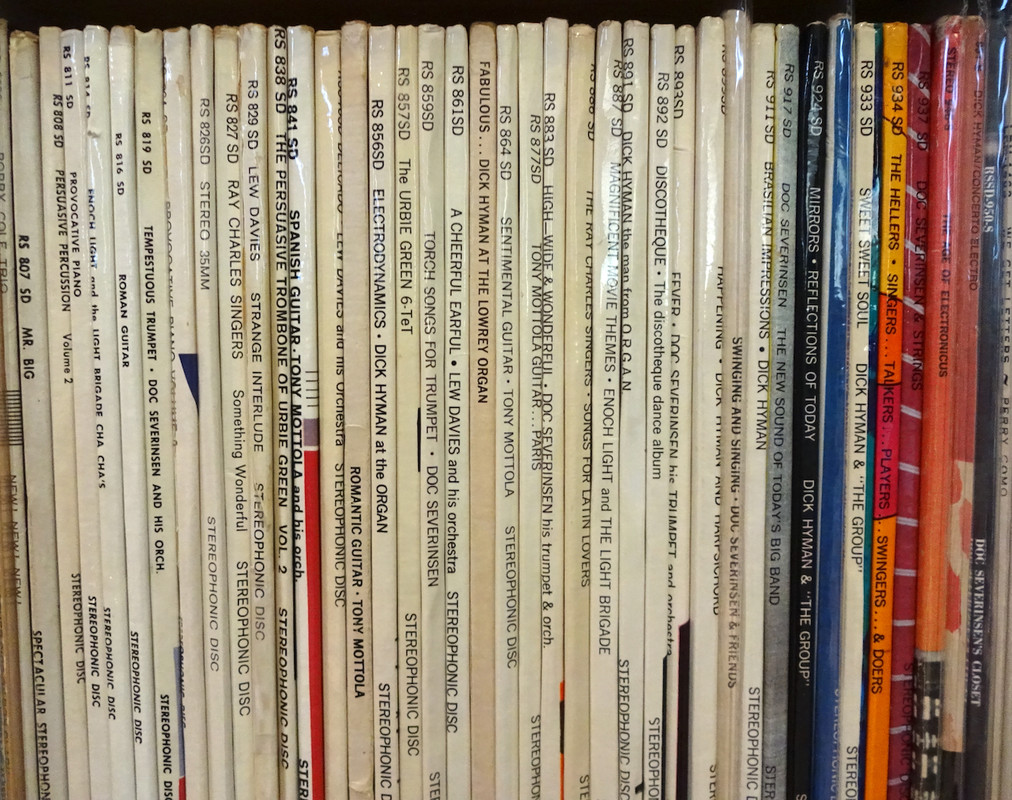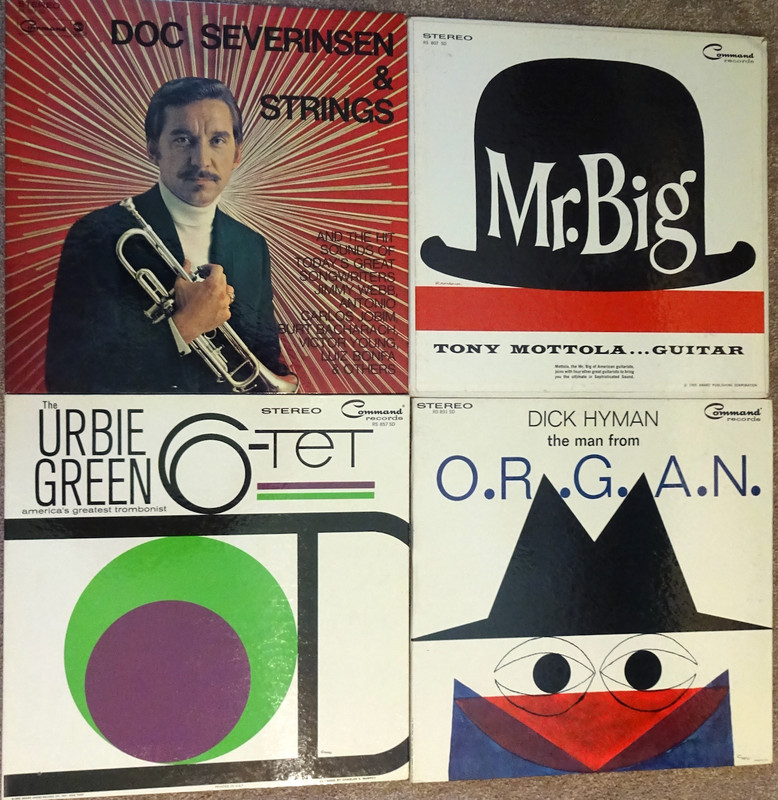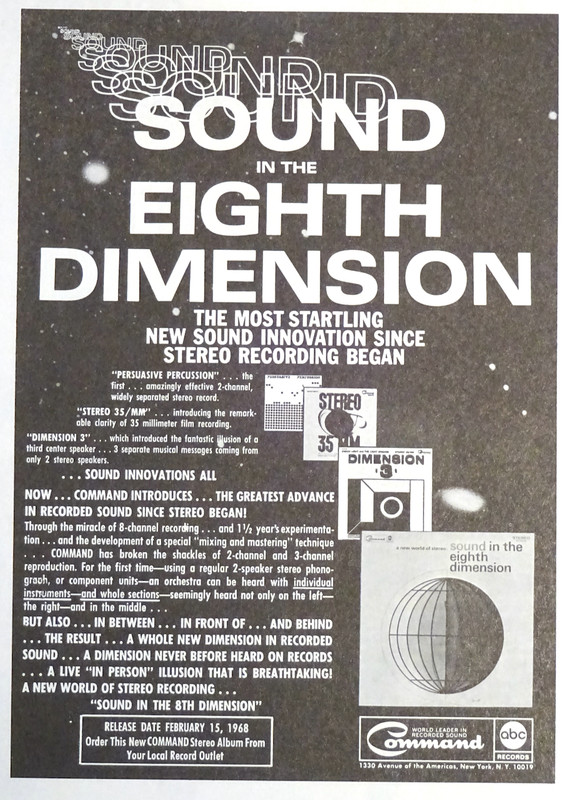As it was explained to me by "Fred" (the senior jazz announcer at the first station I worked at back in the mid-'80s), Command "specifically engineered records to make your $35 Montgomery Wards portable phonograph sound real good"; and he’s correct. Rather than capture the concert house ambience to recreate the illusion of stereo in your living room (understand that back in the late 1950s it was enough just to get a hi-fi stereo console into your living room…let alone be overly concerned with any finer points of stereophonic imaging such as dampening low frequency standing waves or breaking up midrange waves to increase definition), Enoch Light (Command’s proprietor) quickly spearheaded the idea that to the layperson the following mantra would spell aural success for the then-new stereophonic LPs:
Enoch basically shoved stereo — or rather his idea of stereo — into your ears. There were no subtleties. In fact some of the early Command LPs were imaged entirely hard left and hard right thus leaving a sonic void of nullity in the middle.

To do this Enoch visually exaggerated the two-dimensional aspects of stereophonic sound reproduction by emphasizing close-miking techniques to better control sonics. To that end, the close-miking did add presence to the instruments and by pushing nearly all instruments up front in the mix, he produced a flatter, brighter sound at the expense of natural soundstage depth and definition. As a kid these were my favourite sounding LPs. However, as I matured and was able to purchase quality sound reproduction equipment, I later concluded that those Command LPs did not exhibit realistic sound on quality equipment: trumpets sounded glassy, saxophones sounded squawky — and that was through a tube amp using warm EL84s. I don’t have any CDs of these things but could only imagine how a digitized version, mastered to contemporary in-your-face commercial pap standards, would surely decalcify ½ of your spinal column in short order at 92db.
Ironically enough, all that close-miking actually sounds dynamite in monaural (as single-channel sound reproduction moves more direct air by way of delivering a single-point-source of aural punch, which, in the end, was part of what Enoch was after).
Of note, also, was the packaging, which was a trend setter in the hype department. Check this out (from RS 826 SD):
(To which one of my 1990s LP friends — who for all intents and purposes was of the school that all "pop" music made prior to 1967 was of marginal consequence — stated that the only really painful thing with Command records is the music itself.)

In the end, once beyond all the silly ping-pongy stuff, Command, if for nothing else, was the 1959-66 label of Tony Mottola, the 1959-69 label of Dick Hyman, and contained the entirety of Doc Severinsen’s 1960s LP output — and there’s some really good stuff in there.
For those interested, the label has been done to death over in the Hoffman forum (particularly their early-'60s fad of recording onto 35mm film).
~ The word, stereo, means that what you hear in the left speaker should be different than what you hear in the right ~
Enoch basically shoved stereo — or rather his idea of stereo — into your ears. There were no subtleties. In fact some of the early Command LPs were imaged entirely hard left and hard right thus leaving a sonic void of nullity in the middle.

To do this Enoch visually exaggerated the two-dimensional aspects of stereophonic sound reproduction by emphasizing close-miking techniques to better control sonics. To that end, the close-miking did add presence to the instruments and by pushing nearly all instruments up front in the mix, he produced a flatter, brighter sound at the expense of natural soundstage depth and definition. As a kid these were my favourite sounding LPs. However, as I matured and was able to purchase quality sound reproduction equipment, I later concluded that those Command LPs did not exhibit realistic sound on quality equipment: trumpets sounded glassy, saxophones sounded squawky — and that was through a tube amp using warm EL84s. I don’t have any CDs of these things but could only imagine how a digitized version, mastered to contemporary in-your-face commercial pap standards, would surely decalcify ½ of your spinal column in short order at 92db.
Ironically enough, all that close-miking actually sounds dynamite in monaural (as single-channel sound reproduction moves more direct air by way of delivering a single-point-source of aural punch, which, in the end, was part of what Enoch was after).
Of note, also, was the packaging, which was a trend setter in the hype department. Check this out (from RS 826 SD):
Listening to this record can be a shocking experience. It can be exhausting…No record like this has ever been made before. The music is so pure, so totally true, that it is possible to reproduce music of such great intensity that it actually approaches the threshold of pain.
(To which one of my 1990s LP friends — who for all intents and purposes was of the school that all "pop" music made prior to 1967 was of marginal consequence — stated that the only really painful thing with Command records is the music itself.)

In the end, once beyond all the silly ping-pongy stuff, Command, if for nothing else, was the 1959-66 label of Tony Mottola, the 1959-69 label of Dick Hyman, and contained the entirety of Doc Severinsen’s 1960s LP output — and there’s some really good stuff in there.
For those interested, the label has been done to death over in the Hoffman forum (particularly their early-'60s fad of recording onto 35mm film).





